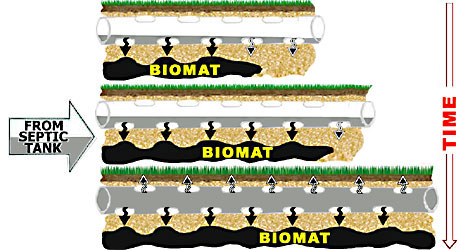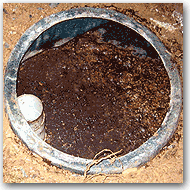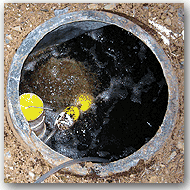Aerobic Septic Systems and Anaerobic – What is the difference between an them?
Anaerobic Septic Systems
“Anaerobic” refers to a system that does not use oxygen. The vast majority of septic tank systems are anaerobic, and have a material known as “biomat” that is designed to break down sewage. This material consists of bacteria that naturally break apart organic waste. However, the lack of oxygen eventually can cause a heavy build-up of bacterial byproducts that forms a slimy sludge within the biomat. The sludge surrounding the biomat usually consists of raw sewage and causes the biomat to grow within the septic tank field. The biomat acts like a shield against the natural organic breakdown process.

Biomat Failing
Much like a clogged artery in the heart, the anaerobic septic systems are clogged with sludge, leading to septic tank problems. When new wastewater is introduced into the septic tank system, the septic system experiences problems because it has no room to process the new wastewater. This results in septic tank problems such as back-ups, overflows, pooling, and unpleasant odors. The septic tank field becomes filled with the biomat and sludge, and wastewater either backs up into the house or into the surrounding outdoor field.
Aerobic Septic Systems
In the past, many homeowners removed and replaced their entire septic system in order to deal with sludge removal. However, the sludge in the biomat can be broken up using aerobic, or oxygen-based, bacteria. By changing an anaerobic septic system to an aerobic septic system, homeowners will not only experience a clean, evenly flowing septic system, but they will save considerable amounts of money and time. The aerobic bacteria prevents the future build-up of the biomat and sludge, keeping the septic system functioning properly. This extends the overall life of the system, helping homeowners save money and time on maintenance.
 Before Remediation |
 After Remediation |
The naturally present aerobic bacteria in a septic tank system is relatively simple to grow, and does not require that the tank be moved, replaced, or otherwise permanently altered. Other methods of handling septic tank problems, including pumping or introducing so-called “bugs” or other chemical agents into the system are temporary fixes and ultimately do not solve the underlying biological problem within the septic tank system. Septic tanks and the components of the septic tank system themselves are generally constructed from extremely durable materials such as PVC plastic, fired clay pipe, and concrete. Anaerobic systems are designed to naturally break down organic sewage and waste, but are not very efficient.
The Aero-Stream Aerobic Remediation Solution
By using an aerobic septic kit to introduce oxygen into the septic tank and turn it into an aerobic environment, the sludge is immediately broken up and the normal processing of wastewater can continue within the septic tank. The underlying materials within an aerobic septic system can last for decades; it is only the development of sludge that causes the septic tank problems. Using septic tank remediators such as Aero-Stream changes the septic tank from an anaerobic to an aerobic environment, breaking up sludge and restoring the smooth flow of the septic system.
Below are 4 videos showing various septic system types (a conventional septic system, a mound system, and a drywell / seepage pit system.) The first video contains an intro to septic system problems as well as past and present solutions, while the rest of the videos explain each system type in more detail.
How to Fix Septic System Problems – Intro
Septic System Types
Conventional System:
Mound System:
Drywell/Seepage Pit:
For more information, contact us by filling out our online contact form or call us at (877) 254-7093. You can also buy our septic remediator online right now.

